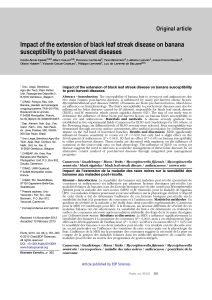Ewané C.A., Chillet M., Castelan F., Brostaux Y., Lassois L., Essoh Ngando J., Hubert O., Chilin-Charles Y., Lepoivre P., de Lapeyre de Bellaire L.
The susceptibility of banana fruit to crown rot and anthracnose, the two main banana post-harvest diseases, is influenced by many pre-harvest abiotic factors. Mycosphaerella leaf spot diseases (MLSD) of bananas are biotic pre-harvest factors, which have an influence on fruit physiology. The fruit’s susceptibility to post-harvest diseases may also be influenced by foliar diseases caused by M. fijiensis, responsible for black leaf streak disease (BLSD), and M. musicola, which causes sigatoka disease (SD). The aim of our study was to determine the influence of these biotic pre-harvest factors on banana fruit’s susceptibility to crown rot and anthracnose. Materials and methods. A disease severity gradient was established in two experimental fields (Cameroon for BLSD and Guadeloupe for SD) where, at the flowering stage, six different levels of MLSD severity were selected. Fruit susceptibility was determined through necrotic surface assessments after artificial inoculation by Colletotrichum musae on the 3rd hand of harvested bunches. Results and discussion. BLSD significantly influenced banana sensitivity to crown rot (P < 0.001) but only had a slight effect on the development of anthracnose (P = 0.041). SD had no effect (P > 0.05) on banana susceptibility to either post-harvest disease. These results are discussed with emphasis on the influence of variations in the source-sink ratio on fruit physiology. The influence of BLSD on crown rot disease suggests the need to take into account the management of these foliar diseases for an alternative control method of post-harvest diseases through integrated pest management programs.
Consultez la notice complète de l’article sur ORBi

